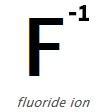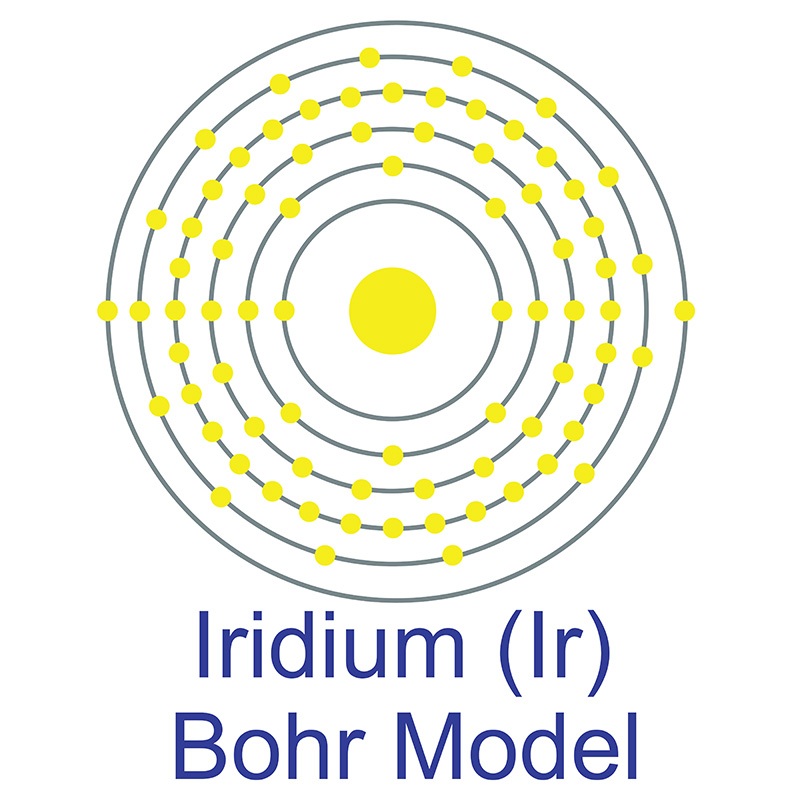SECTION 1. IDENTIFICATION
Product Name: Iridium Hexafluoride
Product Number: All applicable American Elements product codes, e.g. IR6-F-02
, IR6-F-03
, IR6-F-04
, IR6-F-05
CAS #: 7783-75-7
Relevant identified uses of the substance: Scientific research and development
Supplier details:
American Elements
10884 Weyburn Ave.
Los Angeles, CA 90024
Tel: +1 310-208-0551
Fax: +1 310-208-0351
Emergency telephone number:
Domestic, North America: +1 800-424-9300
International: +1 703-527-3887
SECTION 2. HAZARDS IDENTIFICATION
Classification of the substance or mixture
Corrosive to metals, Category 1
Skin corrosion, Category 1B

Signal word
Danger
Hazard statement(s)
H290 May be corrosive to metals
H314 Causes severe skin burns and eye damage
Precautionary statement(s)
Prevention
P234 Keep only in original packaging.
P260 Do not breathe dust/fume/gas/mist/vapours/spray.
P264 Wash ... thoroughly after handling.
P280 Wear protective gloves/protective clothing/eye protection/face protection.
Response
P390 Absorb spillage to prevent material damage.
P301+P330+P331 IF SWALLOWED: Rinse mouth. Do NOT induce vomiting.
P303+P361+P353 IF ON SKIN (or hair): Take off immediately all contaminated clothing. Rinse skin with water [or shower].
P363 Wash contaminated clothing before reuse.
P304+P340 IF INHALED: Remove person to fresh air and keep comfortable for breathing.
P310 Immediately call a POISON CENTER/doctor/…
P321 Specific treatment (see ... on this label).
P305+P351+P338 IF IN EYES: Rinse cautiously with water for several minutes. Remove contact lenses, if present and easy to do. Continue rinsing.
Storage
P406 Store in a corrosion resistant/...container with a resistant inner liner.
P405 Store locked up.
SECTION 3. COMPOSITION/INFORMATION ON INGREDIENTS
Chemical name / Common names and synonyms / CAS number
Iridium hexafluoride / Iridium hexafluoride / 7783-75-7
SECTION 4. FIRST AID MEASURES
Description of necessary first-aid measures
General advice
Consult a physician. Show this safety data sheet to the doctor in attendance.
If inhaled
If breathed in, move person into fresh air. If not breathing, give artificial respiration. Consult a physician.
In case of skin contact
Wash off with soap and plenty of water. Consult a physician.
In case of eye contact
Rinse thoroughly with plenty of water for at least 15 minutes and consult a physician.
If swallowed
Never give anything by mouth to an unconscious person. Rinse mouth with water. Consult a physician.
Most important symptoms/effects, acute and delayed
no data available
SECTION 5. FIREFIGHTING MEASURES
Extinguishing media
Suitable extinguishing media
Use water spray, alcohol-resistant foam, dry chemical or carbon dioxide.
Specific hazards arising from the chemical
no data available
Special protective actions for fire-fighters
Wear self-contained breathing apparatus for firefighting if necessary.
SECTION 6. ACCIDENTAL RELEASE MEASURES
Personal precautions, protective equipment and emergency procedures
Use personal protective equipment. Avoid dust formation. Avoid breathing vapours, mist or gas. Ensure adequate ventilation. Evacuate personnel to safe areas. Avoid breathing dust. For personal protection see section 8.
Environmental precautions
Prevent further leakage or spillage if safe to do so. Do not let product enter drains. Discharge into the environment must be avoided.
Methods and materials for containment and cleaning up
Pick up and arrange disposal. Sweep up and shovel. Keep in suitable, closed containers for disposal.
SECTION 7. HANDLING AND STORAGE
Precautions for safe handling
Avoid contact with skin and eyes. Avoid formation of dust and aerosols. Avoid exposure - obtain special instructions before use.Provide appropriate exhaust ventilation at places where dust is formed. For precautions see section 2.2.
Conditions for safe storage, including any incompatibilities
Store in cool place. Keep container tightly closed in a dry and well-ventilated place.
SECTION 8. EXPOSURE CONTROLS/PERSONAL PROTECTION
Control parameters
Occupational Exposure limit values
no data available
Biological limit values
no data available
Appropriate engineering controls
Handle in accordance with good industrial hygiene and safety practice. Wash hands before breaks and at the end of workday.
Individual protection measures, such as personal protective equipment (PPE)
Eye/face protection
Safety glasses with side-shields conforming to EN166. Use equipment for eye protection tested and approved under appropriate government standards such as NIOSH (US) or EN 166(EU).
Skin protection
Wear impervious clothing. The type of protective equipment must be selected according to the concentration and amount of the dangerous substance at the specific workplace. Handle with gloves. Gloves must be inspected prior to use. Use proper glove removal technique(without touching glove's outer surface) to avoid skin contact with this product. Dispose of contaminated gloves after use in accordance with applicable laws and good laboratory practices. Wash and dry hands. The selected protective gloves have to satisfy the specifications of EU Directive 89/686/EEC and the standard EN 374 derived from it.
Respiratory protection
Wear dust mask when handling large quantities.
Thermal hazards
no data available
SECTION 9. PHYSICAL AND CHEMICAL PROPERTIES
Physical state no data available
Colour no data available
Odour no data available
Melting point/ freezing point no data available
Boiling point or initial boiling point and boiling range no data available
Flammability no data available
Lower and upper explosion limit / flammability limit no data available
Flash point no data available
Auto-ignition temperature no data available
Decomposition temperature no data available
pH no data available
Kinematic viscosity no data available
Solubility no data available
Partition coefficient n-octanol/water (log value) no data available
Vapour pressure no data available
Density and/or relative density no data available
Relative vapour density no data available
Particle characteristics no data available
SECTION 10. STABILITY AND REACTIVITY
Reactivity
no data available
Chemical stability
Stable under recommended storage conditions.
Possibility of hazardous reactions
no data available
Conditions to avoid
no data available
Incompatible materials
no data available
Hazardous decomposition products
no data available
SECTION 11. TOXICOLOGICAL INFORMATION
Acute toxicity
Oral: no data available
Inhalation: no data available
Dermal: no data available
Skin corrosion/irritation
no data available
Serious eye damage/irritation
no data available
Respiratory or skin sensitization
no data available
Germ cell mutagenicity
no data available
Carcinogenicity
no data available
Reproductive toxicity
no data available
STOT-single exposure
no data available
STOT-repeated exposure
no data available
Aspiration hazard
no data available
SECTION 12. ECOLOGICAL INFORMATION
Toxicity
Toxicity to fish: no data available
Toxicity to daphnia and other aquatic invertebrates: no data available
Toxicity to algae: no data available
Toxicity to microorganisms: no data available
Persistence and degradability
no data available
Bioaccumulative potential
no data available
Mobility in soil
no data available
Other adverse effects
no data available
SECTION 13. DISPOSAL CONSIDERATIONS
Disposal methods
Product
The material can be disposed of by removal to a licensed chemical destruction plant or by controlled incineration with flue gas scrubbing. Do not contaminate water, foodstuffs, feed or seed by storage or disposal. Do not discharge to sewer systems.
Contaminated packaging
Containers can be triply rinsed (or equivalent) and offered for recycling or reconditioning. Alternatively, the packaging can be punctured to make it unusable for other purposes and then be disposed of in a sanitary landfill. Controlled incineration with flue gas scrubbing is possible for combustible packaging materials.
SECTION 14. TRANSPORT INFORMATION
UN Number
ADR/RID: no data available IMDG: no data available IATA: no data available
UN Proper Shipping Name
ADR/RID: no data available
IMDG: no data available
IATA: no data available
Transport hazard class(es)
ADR/RID: no data available IMDG: no data available IATA: no data available
Packing group, if applicable
ADR/RID: no data available IMDG: no data available IATA: no data available
Environmental hazards
ADR/RID: no IMDG: no IATA: no
Special precautions for user
no data available
Transport in bulk according to Annex II of MARPOL 73/78 and the IBC Code
no data available
SECTION 15. REGULATORY INFORMATION
European Inventory of Existing Commercial Chemical Substances (EINECS) Listed.
EC Inventory Listed.
United States Toxic Substances Control Act (TSCA) Inventory Not Listed.
China Catalog of Hazardous chemicals 2015 Not Listed.
New Zealand Inventory of Chemicals (NZIoC) Not Listed.
Philippines Inventory of Chemicals and Chemical Substances (PICCS) Not Listed.
Vietnam National Chemical Inventory Not Listed.
Chinese Chemical Inventory of Existing Chemical Substances (China IECSC) Not Listed.
SECTION 16. OTHER INFORMATION
Safety Data Sheet according to Regulation (EC) No. 1907/2006 (REACH). The above information is believed to be correct but does not purport to be all inclusive and shall be used only as a guide. The information in this document is based on the present state of our knowledge and is applicable to the product with regard to appropriate safety precautions. It does not represent any guarantee of the properties of the product. American Elements shall not be held liable for any damage resulting from handling or from contact with the above product. See reverse side of invoice or packing slip for additional terms and conditions of sale. COPYRIGHT 1997-2022 AMERICAN ELEMENTS. LICENSED GRANTED TO MAKE UNLIMITED PAPER COPIES FOR INTERNAL USE ONLY.

 The iridium atom has a radius of 136 pm and a Van der Waals radius of 202 pm. Iridium was discovered and first isolated by Smithson Tennant in 1803. In its elemental form, Iridium has a silvery white appearance. Iridium is a member of the
The iridium atom has a radius of 136 pm and a Van der Waals radius of 202 pm. Iridium was discovered and first isolated by Smithson Tennant in 1803. In its elemental form, Iridium has a silvery white appearance. Iridium is a member of the  It is the most corrosion resistant metal known and is the second-densest element (after
It is the most corrosion resistant metal known and is the second-densest element (after 
